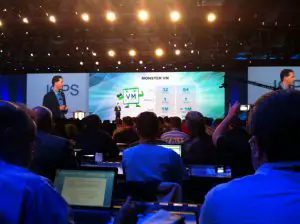Today at VMworld, VMware announced the availability of version 5.1 of its infrastructure products. New CEO Pat Gelsinger likened the release schedule of VMware’s infrastructure product to the Intel tick-tock release of a major every two years and minor revision on the year in between each major, but for a minor (tock) release, version 5.1 of vSphere includes a number of major enhancements.
Among the features in this release, virtual machines will have a new virtual machine format – version 9 – that will allow for larger virtual machines, performance counters and shared graphics acceleration. That’s not the only upgrade to VM’s in the release – a new version of VMware Tools will accompany the release, but this version of tools will mark the end of reboots for subsequent VMware Tool upgrades. That is welcome news for all administrators.
 In addition to these VM enhancements, overall compute capabilities within virtual machines has been enhanced. The MonsterVM, introduced last year with vSphere 5.0, seems to have been working out over the past year. He’s back and bigger (see the photo to the right). VMs can scale to 64 vCPU’s per and can handle over 1 million IOPS per VM.
In addition to these VM enhancements, overall compute capabilities within virtual machines has been enhanced. The MonsterVM, introduced last year with vSphere 5.0, seems to have been working out over the past year. He’s back and bigger (see the photo to the right). VMs can scale to 64 vCPU’s per and can handle over 1 million IOPS per VM.
In the networking space, VMware has made a number of enhancements to the vSphere Distributed Switch. VMware has added network health check, configuration backup and restore, rollback and Link Aggregation Control Protocol support. Chris Wahl of the Wahl Network has posted a deep dive of the new features in vSphere Distributed Switch for version 5.1.
In terms of storage, one of the stand-out new features is shared-nothing Storage vMotion – meaning that you can move VM’s between clusters that don’t share common storage with zero downtime. This extends vMotion to direct attached storage and clusters with different SAN attached storage.
Another major new feature is the vSphere Web Client, enabling cross-browser administration of vSphere deployments in a capable web interface. Not only is it full-featured and impressive-looking from demonstration, but it is extensible and will allow third-party plug-ins from partner companies to enable direct hardware and software management from within the vSphere (and vCloud Director) web interface. CTO Steve Herrod said that the lines between vCloud Director and vCenter have begun to blur and this is a towards unification of those two management interfaces. Single Sign-On has also been added to allow users to sign into the web client once and not be required to sign in, again, to additional components. Orchestrator has also been integrated and can be launched directly from the web client.
For all the details of What’s New, see this guide from VMware.
